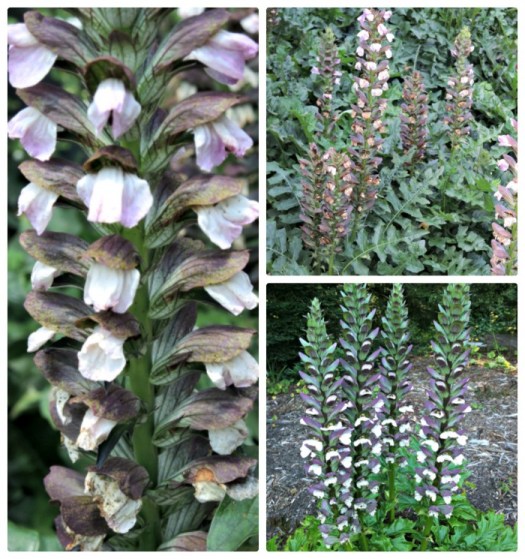
In my garden tours and travels I see many similar perennials used over and over, the same Coreopsis, Coneflowers, and Salvias. But once in a while I spot an unusual perennial that stands out and I wonder why it isn’t used more. Highlighting some of these standouts in this post, both under-used and under-appreciated, I hope will entice gardeners to try something maybe out of their comfort zone. Some are readily available, but others will take some work to find, but worth the search. Two are native – the Flax plant and the Culver’s Root – and the other two are not.
Bear’s Breeches – Acanthus mollis

Commonly known as Bear’s Breeches, the flowers do somewhat resemble little upside down pantaloons. The foliage has a dark green glossy attractive lobed form which inspired the Corinthian leaf used in ancient Greek art. Architecturally bold flower spikes with creamy white and blue snap dragon-like flowers rise up to 3-5′ tall above the foliage and last for weeks and dry on the plant, lasting until fall. Slow to establish, but once growing well, will steadily increase in size using underground roots. Hardy in zones 6 to 10, it is evergreen in warmer zones. Another variety, Acanthus spinosus has spinier thistle-like leaves that is hardier. Providing bold structure in the sun or partial shade, Acanthus deserves more popularity. Easily available at well stocked nurseries, the spinosus one is a little harder to find.


Originally from the Mediterranean region, Bear’s Breeches roots were used medicinally historically. I have had this plant for at least 20 years and it has spread to an area about 5 ‘ by 5’ from one plant. But it isn’t invasive, as it is easy to pull up by the roots to keep under control. Oh, yes, it is deer resistant!
Culver’s Root – Veronicastrum virginicum

Growing Culver’s Root for many years, I am just beginning to see it used in more public and private gardens. Position Culver’s Root among shorter perennials to support the tall candelabra shaped spikes that are lined with tiny white or pale blue flowers. Towering up to 6 feet tall, sprinkle the plants in your planting bed so that you can watch the pollinators visit. A valuable nectar-rich plant, Culver’s Root is always covered with bees when it blooms in June and July.


A native plant, Culver’s Root was used by native Americans as an emetic. Named after Dr Culver who popularized its use as a powerful cathartic in the eighteenth century, be careful using this for medicinal purposes. The famous Puritan leader, Cotton Mather, had his ill daughter dosed with Culver’s Root and she died soon after in the sixteenth century, reputedly from poisoning.
There is one named cultivar called Lilac Towers, which is a nice color addition to the genus.

Providing the unexpected combination of strong structure and graceful airiness to the landscape, the blooms last for weeks in the mid to late summer. Blooms emerge from whorls of distinctive foliage arranged around the length of the sturdy stems.

I have never seen this available at a retail nursery, but have seen it at native plant sales.

Gas Plant – Dictamnus albus
Gas plant, Dictamnus albus, also called dittany or burning bush, is native to Eurasia and is grown as an ornamental in many places. Commonly seen in old fashioned cottage gardens, I love spotting it in more modern garden settings.



Why is it called Gas Plant? The flowers (white or pink) and old flowers or seed pods emit a flammable oil, which on a windless summer evening, can be ignited with a match resulting in a brief vapor burn which is harmless to the plant. Wow, a plant that goes up in flames!! I love it!
Flax Plant – Linum lewesii
Blue Flax is a classic American native wildflower. Known as Linum lewisii in honor of explorer Meriwether Lewis who remarked upon this species in his journals. Blue Flax prefers full sun, but can tolerate some partial shade as well. Blue Flax is an early bloomer in most climates and a colorful harbinger of spring.

Seen everywhere out west and occasionally on the east coast, this short-lived perennial is easily grown in average, medium, well-drained soils in full sun to part shade. Flax tends to root shallowly in heavy clay soils resulting in increased winter survival problems. That is why I consider it a short-lived perennial here in the mid-Atlantic region with generally heavy soils. Easily grown from seed (some plants may flower the first year). Cut some stems back by 1/2 mid-way through the bloom period to extend flowering. Tolerates heat, humidity and drought. What’s not to like? An airy true blue flower that wafts in the breeze, is a great cut flower, and stays in bloom for weeks.


I need to find a source of this plant locally. I can find it on line, but prefer to buy plants from a local nursery. Easy to find at seed companies, it would be worth it to start it from seed.
Now is the time to start looking for these plants/seeds at local nurseries. Go to my post on pesticide free nurseries for suggestions.



